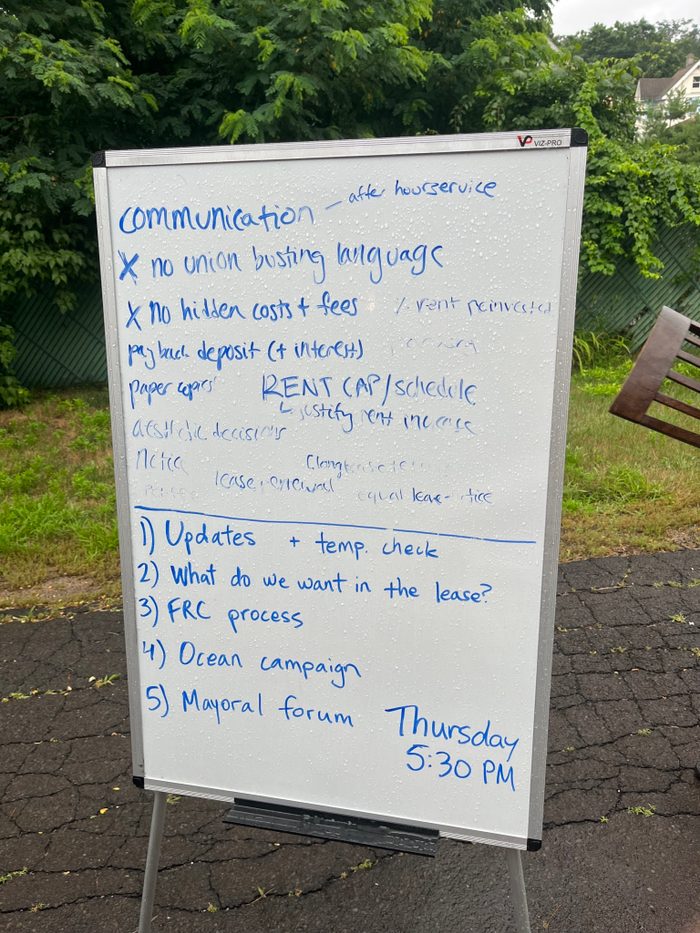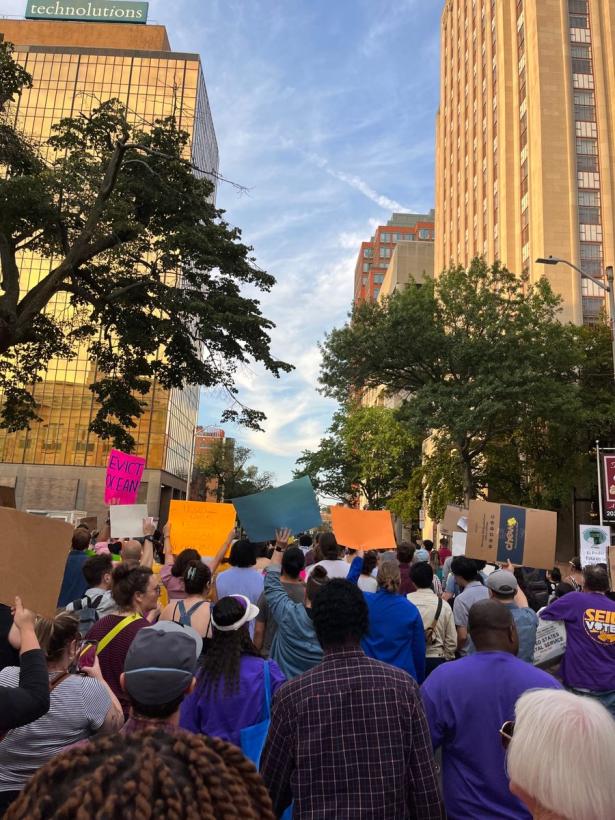NEW HAVEN, CONN. — Things looked bleak on Blake Street when, at around 3:30 p.m. on August 19, Jessica Stamp and 15 of her neighbors found eviction notices taped to their door.
Ocean Management, Stamp’s landlord and one of New Haven’s most powerful companies, seemed intent on getting her out. But 13 days later, on Sept. 1, Ocean called off the evictions and came to the bargaining table to negotiate the first agreement of its kind between a landlord and tenants in Connecticut.
In those 13 days, a local tenants union realized just how powerful they’d become.
Going Against “Goliath”
Ocean is one of New Haven’s largest landlords, owning roughly 300 New Haven properties containing approximately 1,000 units. The company is notorious for frequent appearances in housing court: Tenants’ complaints have resulted in the city’s housing agency issuing thousands of code violations. According to an analysis of city records I conducted for the New Haven Independent, as of August, Ocean allowed nearly 94% of its rental licenses to expire, substantially diminishing any chance these properties would be inspected for safety and quality.
A representative for both Ocean and the company’s owner, Shmuel (Shmulik) Aizenberg, declined to comment for this story.
The evictions came at a stressful, uncertain time for the union. A few weeks prior, Ocean lit the fuse that would eventually spark the evictions by beginning to call the residents of Elizabeth Apartments, the 70-unit building in which BSTU is based, to tell them their rent was going up 20 to 30%. These increases ranged from $220 to as high as $285, according to internal data collected by the union, all but guaranteeing some residents would be displaced. Among those affected were seniors, tenants on fixed income and multiple disabled tenants, including Michael Portee, an intellectually disabled man with epilepsy, who was hit with a $250 increase.
“We went into a panic because he works but his paycheck is not enough to afford rent,” says Marcia Tourangeau, Portee’s sister and caretaker, who lives across the street from the property. “[The rent increase] would be a devastating blow to him. Why would you do that to him, to anybody in the building? It’s not fair — to him or to anybody like him. Not caring if he’s going to be able to get a place or be on the street.”
The rent increases were the catalyst for the first real battle for BSTU, a one-year-old tenant union founded by labor organizer and Elizabeth tenant Sarah Giovanniello, which had, thus far, mainly managed housing inspections and taken Ocean to court for code violations. Its building-wide capabilities had not yet been tested.
As each rent hike call from Ocean came in, BSTU helped tenants file a complaint with New Haven’s Fair Rent Commission (FRC), which was created as an outlet for tenants to contest unfair or undue rental costs. In 2022, it became the agency tenant unions must go through to obtain official recognition from the city, which allows them to file rental complaints collectively and opens a pathway to collective bargaining. Filing a complaint freezes potential rent increases until the commission determines if they are warranted. The union’s goal, aside from blocking the increases, was to force Ocean to bargain.
“We are asking for you to come to the table and negotiate in order to come up with a plan that’s not going to destroy us,” Stamp said.
On the off chance Ocean would negotiate, the union members started gathering to brainstorm what they wanted to see in their leases — on top of no exorbitant rent increases, of course. The first such meeting began in July in a back lot of the Elizabeth Apartments’ red-brick complex with members writing ideas on a whiteboard. Roughly 15 were present, some reclining on the building’s cement porch stairs, some setting up lawn chairs and sporting big red umbrellas. It had just started to rain.

The whiteboard started to fill up with phrases like “no union-busting language” and “no hidden costs + fees.” By far the most frequent voice came from John Raccio, a mailman who had moved into the building approximately nine months prior. Knowing the precedent BSTU could set, Raccio was determined: “We need language on every possible thing.” Even as the evening wore on, even as the rain kept coming and even as the writing on the board began to fade into illegibility thanks to the water, the group’s ideas kept coming.
As these deliberations began, the looming possibility of FRC intervention finally got Aizenberg’s attention. In late July, he got in touch with the union. He wanted to meet.
So on July 21, Stamp and Giovanniello found themselves across the table from Aizenberg — who, prior to this, had not recognized the union’s existence. It didn’t go well: “Aizenberg was threatening us,” Stamp told In These Times a few hours afterward. “He’s like, ‘There’s no need to go over to the Fair Rent Commission. I was ready to evict you.’”
As the meetings continued in a stalemate, with the union holding strong against the rent increases, Giovanniello was acutely aware of their uncertain standing in contrast to labor union negotiations. Employers are required to bargain in good faith with unions; in Connecticut, and most of the country, landlords are not. This makes BSTU’s pursuit of a list of bargaining demands much trickier — and means more risk.
“I mean, supposedly they’re open to negotiating with us,” Giovanniello told In These Times skeptically in late July, as the meetings continued. “We’ll see how that plays out.”
The 13-Day Fight
Giovanniello soon got her answer. On August 19, rather than negotiate over the rent hike, Ocean followed through on its threat and issued the 16 eviction notices, which stated that tenants had until September 1 to leave voluntarily. That was day one.
BSTU, energized by two months of unity in fighting the rent increases, sprung into action. On day four, after the notices, they held a press conference alongside New Haven’s mayor, demanding Ocean call the evictions off. On day nine, they filed a lawsuit and injunction against Ocean for illegal retaliation. And on day 11, they held a “March for Tenant Power” — the biggest tenant movement demonstration in the city to date.

The rally was organized under the banner of the Connecticut Tenants Union (CTTU), a growing statewide network of renters, led by Hannah Srajer, the group’s president. BSTU is one of 14 local CTTU chapters. In the flex of the community power CTTU has managed to build, speakers at the event included the state legislature’s entire New Haven delegation, SEIU’s former executive director Kooper Caraway and even U.S. Senator Richard Blumenthal (D-Conn.). After the crowd of over 300 marched the five blocks from New Haven City Hall to Ocean Management’s main office, they plastered the door with mock eviction notices directed at the landlord attempting to displace them.

All were there in solidarity with the group that calls itself the Blake Street 16.
“We were marching down the street, everyone’s chanting, and I’m crying,” Stamp said. “It hit me when I was watching all of these people come out for the Blake Street 16. When Blumenthal was talking [at the rally] about how these people shouldn’t be evicted, I was like, I am those people. Like, this is me!”
Less than 48 hours after that show of solidarity, Ocean offered BSTU a historic deal: They rescinded all evictions in favor of a signed agreement that made the collective bargaining process official through December 5. In just 13 days, the union forced Ocean from eviction court to the negotiating table.
For Srajer, this win demonstrates tenant unions’ necessity. She imagines a city in which all rental buildings are unionized, envisioning what they might do with that level of grassroots infrastructure. In her day-to-day work as CTTU’s elected leader, she seeks to generate and replicate wins like BSTU’s and keep sharing the tenant-union vision from renter to renter, from building to building, from town to town.
“Every single person in that property has the ability to organize if they so desire,” Srajer said. “What the tenant union is also doing is rebuilding that tradition of organizing as a skill and a practice and a methodology that is available to everyone who feels compelled to fight.”
“We’re On the Right Path”
BSTU’s organizing has also caught the attention of tenant leaders at the national level.
Tara Raghuveer, the Homes Guarantee campaign director at People’s Action and a leader of the multithousand-member tenant union in Kansas City, Mo., earlier this year penned “The Case for the Tenant Union” — a call for tenants to respond to the untenable housing crisis through unflinching union organizing. In her view, the efforts of the likes of Stamp, Giovanniello and Srajer not only answer that call but serve as a model for tenants across the country.
“I really think the tenant union needs to be for poor and working-class people in the 21st century what a labor union was for poor and working-class people in the 20th century,” Raghuveer said. “And I think it will be. This victory in New Haven is emblematic of a new and renewed clarity that tenants have about the type of fight they’re in, which is really a fight for their lives.”
With the evictions rescinded, BSTU is looking to their next fight — negotiating for the best lease possible, thereby setting the stage for the future of tenant organizing across Connecticut. Though the particulars of the lease — including how much, if at all, the building’s rent will increase — remain in flux, Giovanniello has nonetheless shaken off some of the uncertainty she had felt for so long.
“People feel more confident, and I think more secure, in their decision to act collectively,” she said. “So let’s see how far we can take this.”
For proof, look no further than Raccio, who at 27 years old has become an elected member of the first tenant negotiating team in Connecticut. When asked if he experiences any self-doubt about the union or his work within it, he said the only choice is to keep looking forward.
“This is unprecedented territory as far as the United States goes,” Raccio said. “Regardless of which way the language [of the collective lease] is written, neither party really knows what the result is going to be. So the fact that we’ve been able to blindly navigate our way this far makes me think that we’re on the right path.”
===
Thomas Birmingham is a reporter in New Haven and an intern at In These Times. He has previously written for The Appeal, the Louisville Courier-Journal and the New Haven Independent.
===
Reprinted with permission from In These Times. All rights reserved.
Portside is proud to feature content from In These Times, a publication dedicated to covering progressive politics, labor and activism. To get more news and provocative analysis from In These Times, sign up for a free weekly e-newsletter or subscribe to the magazine at a special low rate.


Spread the word